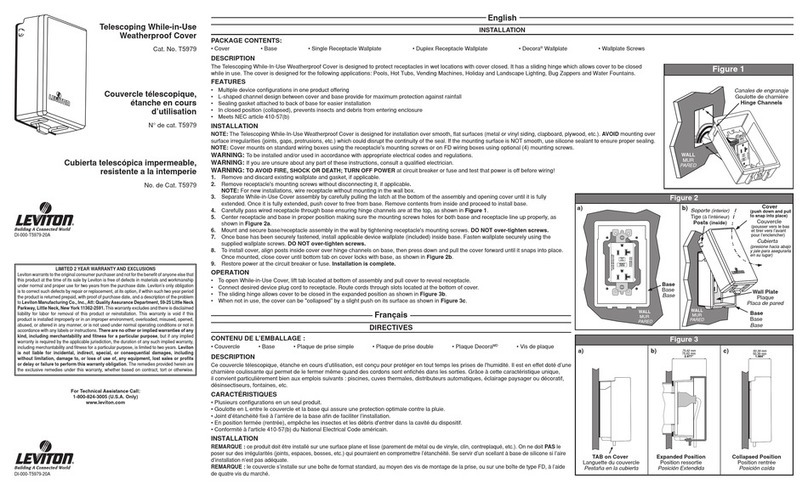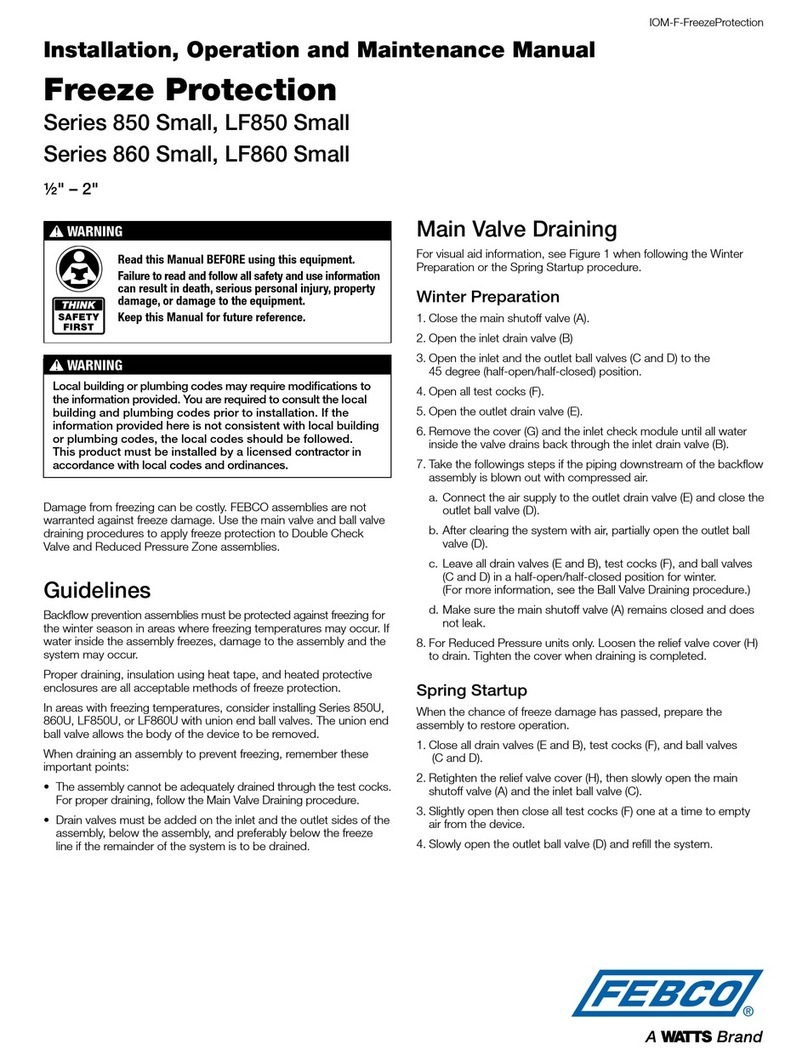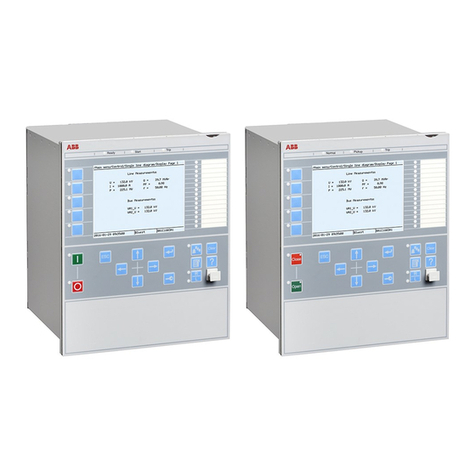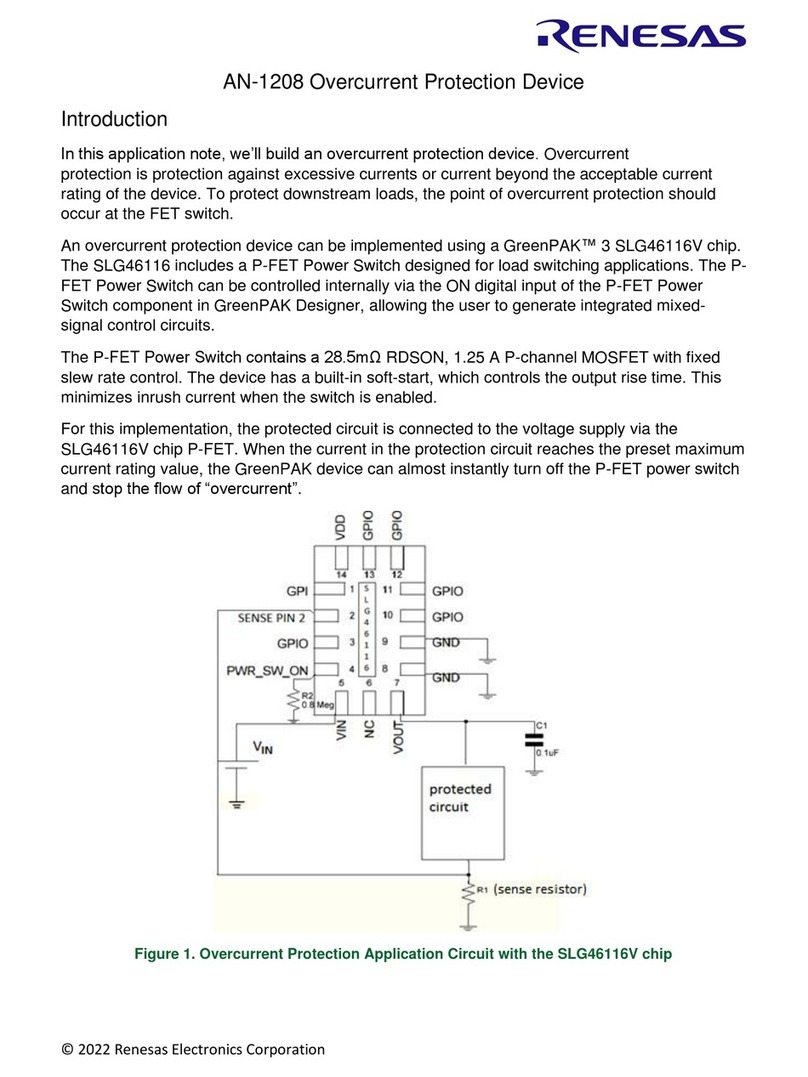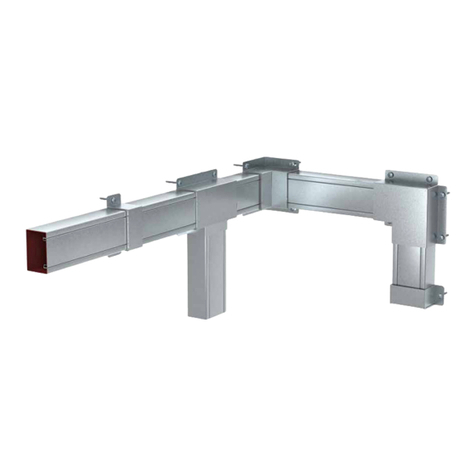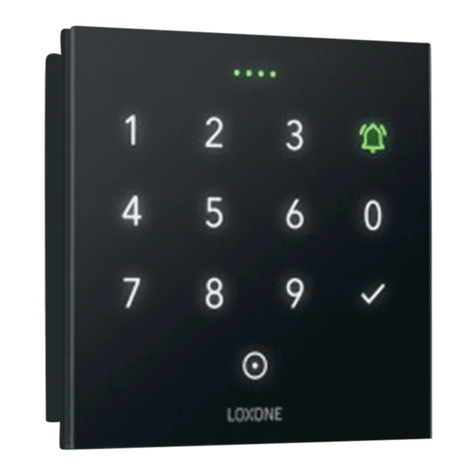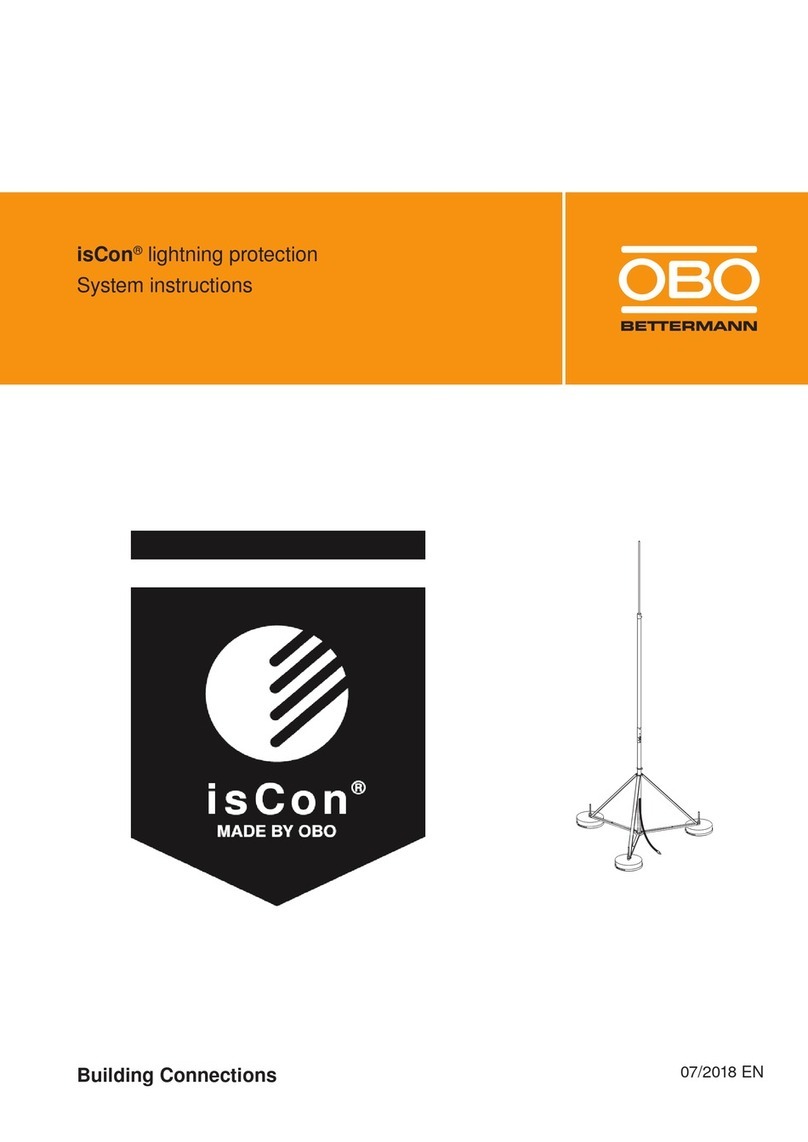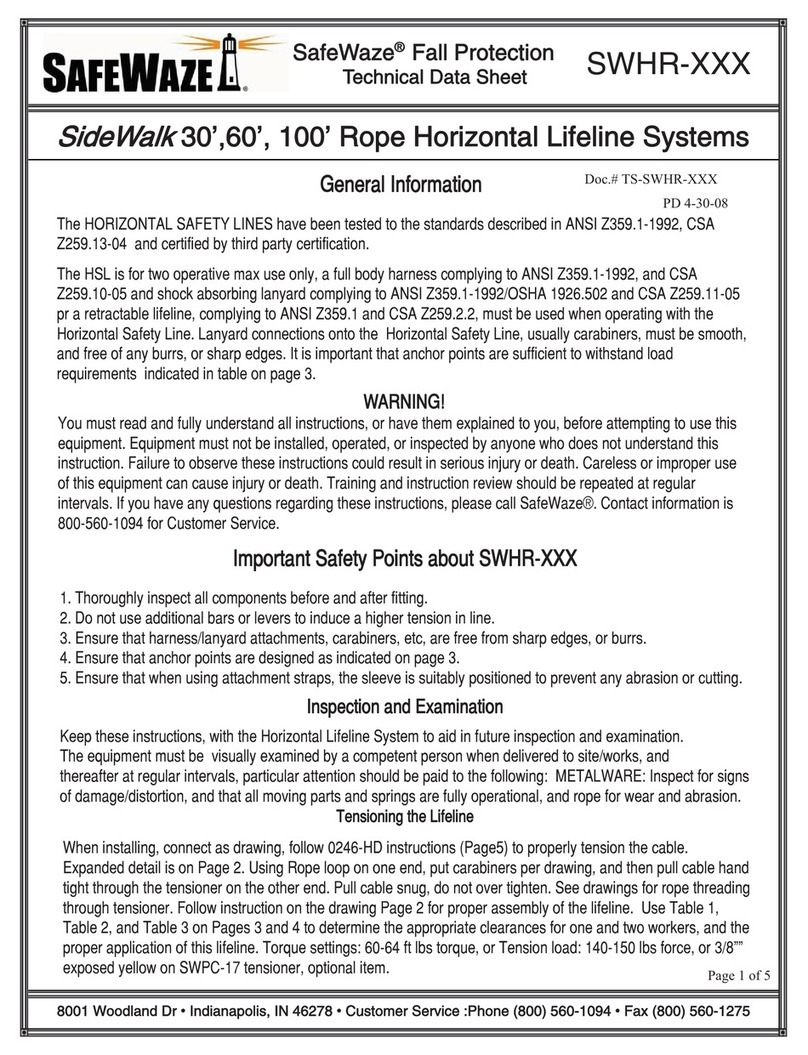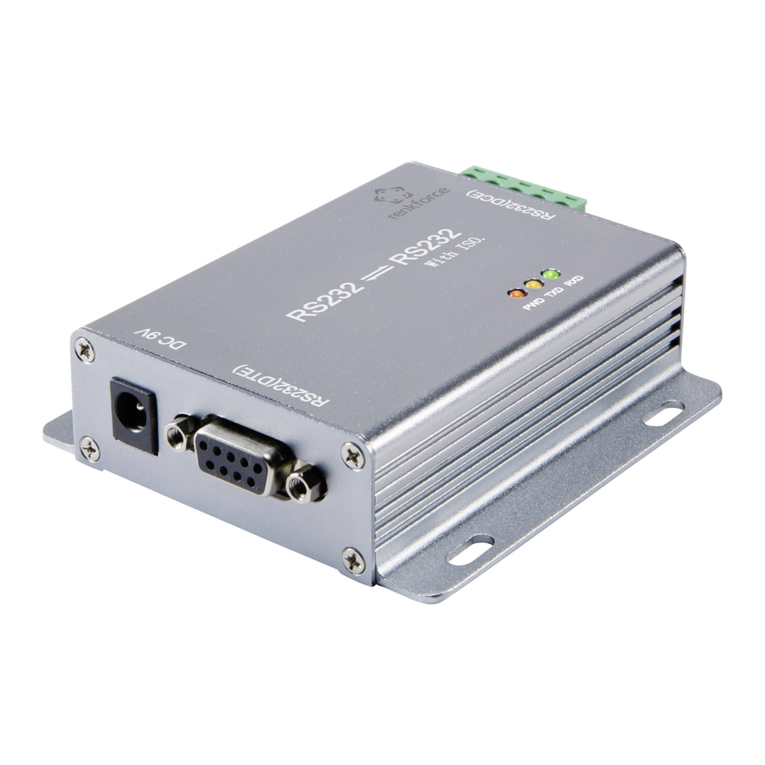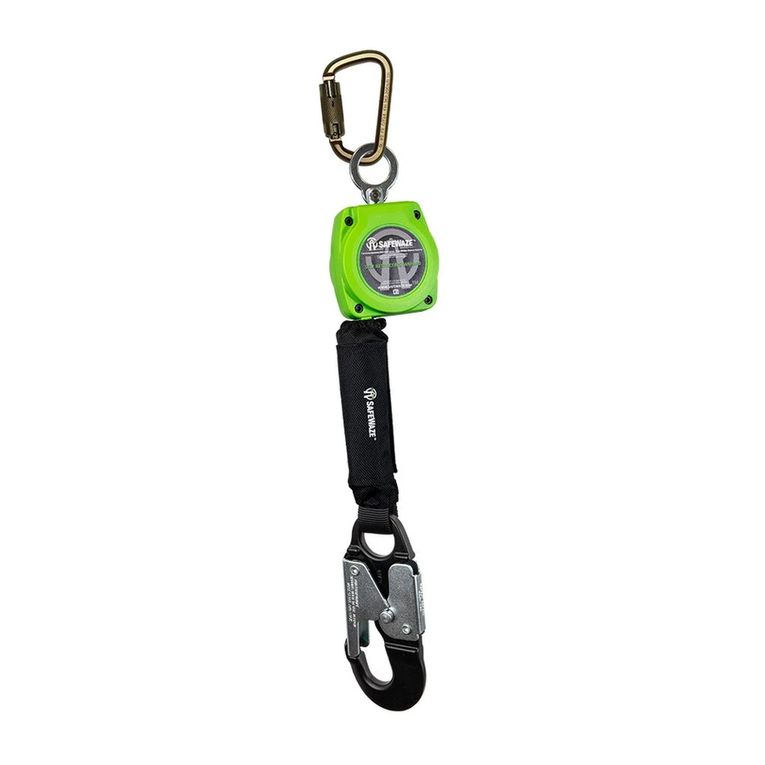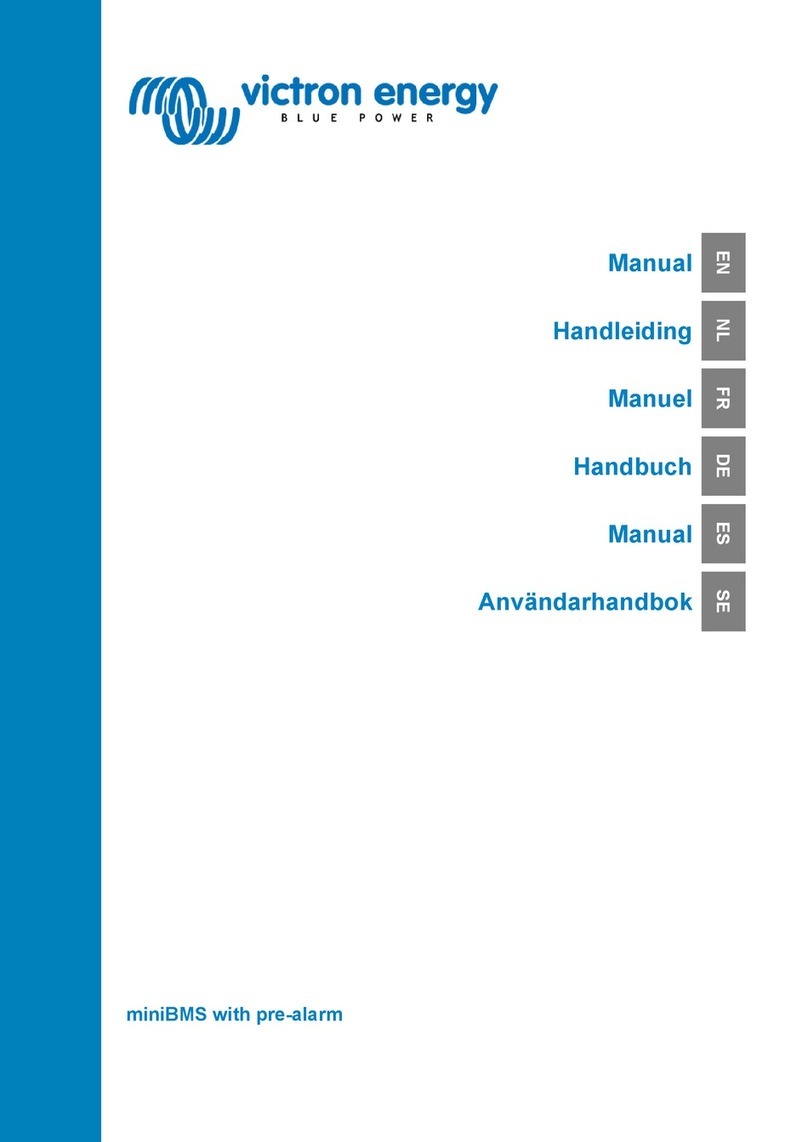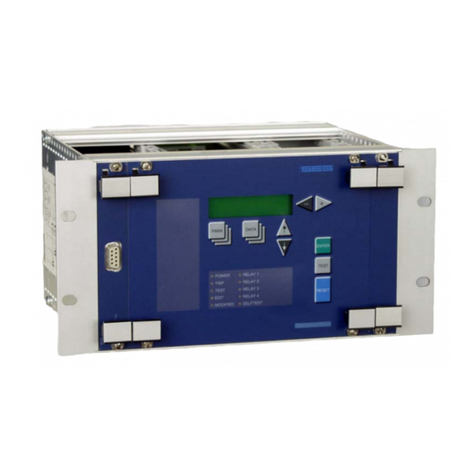ICM Controls ICM441 General instructions

Mode of Operation
The ICM441 is designed to individually monitor 3 PTC temperature sensors which are wound into
each phase winding of a motor. If any winding or incoming line power is beyond the safe operating
range of the motor, the ICM441 will lock the motor out of operation until the inputs fall back into
the safe operating range. The ICM441 can sense shorted or open sensors, in addition to providing
isolation to each sensor to prevent damage to the monitor in the event a sensor shorts to a winding or
case ground.
ICM441 System Wiring Diagram
Installation
This installation is only to be performed by a qualied electrician in accordance with NEC standards.
Ensure all power to both motor and control circuits is removed before starting installation. Verify there
is no voltage present with a voltmeter.
This control is typically installed on a three phase motor, where the power for this control comes
directly off one set of phases to the motor (see System Wiring Diagram). If you have an installation
where a step-down transformer drops the voltage supply for this control, please see the section titled
“Step-Down Transformer Installations.”
In applications where this control replaces an existing motor protector of the same voltage and
sensor ratings, label each wire connected to the defective unit before you remove it from that control.
Terminal designations should correspond to terminals on the ICM441.
Step 1: Verify sensor integrity
There should be four (4) small gage wires coming from the motor housing, which connect to
internally-wound sensors. There are three sensor wires, and one sensor common wire. At normal
temperature, a motor which has been de-energized for at least one hour will have sensors with a
normal operating resistance of approximately 1KΩ. A sensor must be in the range of 500Ωto 3KΩ
when measured with a resistance meter between the sensor common wire and each sensor wire
(S1, S2, and S3). If a sensor is found outside of this range, you must deactivate that sensor from all
sensing, as described in the section labeled “Bypassing A Sensor.”
Step 2: Connect all sensor wires
There should be four (4) small gage wires coming from the motor housing, which connect to
internally-wound sensors. There are three sensor wires, and one sensor common wire. The sensor
common wire connects with female 1/4” quick-connects to the ICM441 terminal “C” (common). All of
the individual sensor wires connect to the ICM441 terminals “S1, S2, and S3” with female 1/4” quick-
connects.
Connect sensor wire S1 to terminal “S1,” connect sensor wire S2 to terminal “S2,” and connect
sensor wire S3 to terminal “S3.” The order of these sensors is not important, simply ensure that
each sensor wire is connected to a sensor input on the ICM441. Consult the System Wiring Diagram
should any other questions arise.
Step 3: Connect the control circuit
There is always a contactor that supplies operating current to the motor this device protects. This
contactor has an internally wound coil with a specic operating voltage rating. Ensure the operating
voltage rating of this coil is in the range of 24 VAC to 277 VAC, since the ICM441 has a maximum
rating of 277 VAC on its internal control contacts.
Usually, one side of the contactor coil is connected to power common. Whether a transformer is used
to step-down the control voltage (see the section titled “Step-Down Transformer Installations”) or if it
is powered by line voltage, one side of the coil is typically connected directly to this common. Leave
this connection to the contactor coil as is.
The other side of the contactor coil typically is energized by “hot” through a series of switches, usually
by some type of thermostat, pressure switch, or safety switch. Remove this “switched side” coil wire
from the contactor coil and connect to the ICM441 terminal “M2” using a 1/4” female quick-connect.
Fashion another wire with female 1/4” quick-connects on both ends to connect between the ICM441
terminal “M1” and the “switched side” of the coil you just removed the wire from. Consult the System
Wiring Diagram should any other questions arise.
Step 4: Supply operating voltage to the ICM441
The operating voltage required for this unit is 120/240 VAC, 50/60 Hz. Determine what voltage range
will be supplied to the ICM441 and connect voltage as follows:
• 85-135 VAC: Connect Neutral (or “common” on step-down transformer applications) to the terminal
labeled “L1” on the ICM441, via a 1/4” female quick-connect. Connect L1 (or “hot” on step-down
transformer applications) to the terminal labeled “LO” on the ICM441, via a 1/4” female quick-
connect. You may connect an additional wire between terminals “LO” and “L2” on the ICM441, but
this option is not required. Terminal “L2” has no internal connection, it is provided for backward
compatibility to other models of motor protector.
• 185-277 VAC: Connect L1 (or “common” on step-down transformer applications) to the terminal
labeled “L1” on the ICM441, via a 1/4” female quick-connect. Connect L2 (or “hot” on step-down
transformer applications) to the terminal labeled “HI” on the ICM441, via a 1/4” female quick-
connect. You may connect an additional wire between terminals “HI” and “L2” on the ICM441, but
this option is not required. Terminal “L2” has no internal connection, it is provided for backward
compatibility to other models of motor protector.
Consult the System Wiring Diagram should any other questions arise. Your ICM441 is now ready for
application of power to the motor and control circuits.
Specification
ENVIRONMENTAL
Epoxy Encapsulated: For use in extreme environmental conditions
Connection Terminals: 0.25” male spade terminals
Temperature Range: -40ºC to 85ºC (storage) -40ºC to 70ºC (operating)
Maximum Operating/Storage Relative Humidity: 95% non-condensing
Sensor Shorted, Open, Over Temperature Detection: 0.1 second maximum
Power Loss Detection: 0.1 second maximum
Nominal anti-short cycle Time: 4 minutes (+/- 60 seconds)
Case Dimensions: 3”L x 3.25”W x 1.5”H
ELECTRICAL
User Selectable Operating Voltage: 90-140 VAC RMS and 185-270 VAC RMS (based on eld wiring)
Low Voltage Cutout: 85 (+/-5.5) VAC RMS (using 120 VAC input) 170 (+/-10) VAC RMS (using 208 VAC input)
Over Temperature Trip: Any one sensor input in excess of 11KΩ(+/- 1KΩ)
Over Temperature Reset: All three sensor inputs must be less than 3KΩ(+/- 500Ω)
Shorted Sensor Trip: Any one sensor input less than 250Ω(+/- 50Ω)
Shorted Sensor Reset: All three sensor inputs must be greater than 500Ω(+/- 100Ω)
N.O. Relay Contact Rating (M1, M2): 2.5 amps resistive @ 277 VAC RMS 2.5 amps inductive @ 277 VAC RMS
Low Power Consumption: 23mA (nominal) @ 120 VAC @ 25ºC 21mA (nominal) @ 240 VAC @ 25ºC
Terminal “L2” is Not Internally Connected: Provided for backward compatibility to competitor models. Not
required for new installations
Temperature Sensors: Monitors industry standard (3BA and 10BA sensors)
ICM441 Cross Reference Guide
ICM # T.I. # Mars # Copeland # Bristol #
441 31AA1606 E 241680
15AA1603 B 37304 Replaces: 071-9800-01
Used On: Copeland: GR, SE
15AA1603 C 37306 Replaces: 071-9800-00
Used On: Copeland: GR, SE
31AA1600 E 37322 Replaces: 071-0376-01 071-0397-00 071-0424-00
071-0376-02 071-0397-01 071-0424-01
Used On: Copeland: 4R, 6R, BR, M, 2D, 3D, 4, 6, 8, both Reed & Discus
models
15AA1600 B 37300 Replaces: 071-0376-02 071-0397-01 071-0424-01
Used On: Copeland: 4R, 6R, BR
15AA1600 C 37302 Replaces: 071-0376-01 071-0397-00
Used On: Copeland: 4R, 6R, BR
Installation of the ICM441 shall be performed by trained technicians only. Adhere to all local
and national electric codes.
Disconnect all power to the system before making any connections.
Caution
ICM441
Motor Protector
Installation, Operation & Application Guide
For more information on our complete range of American-made products – plus
wiring diagrams, troubleshooting tips and more, visit us at www.icmcontrols.com

Troubleshooting
Problem Possible Cause Corrective Action
Motor does not
energize
Your control circuit is
not calling for motor
to energize
Measure voltage across terminals M1 and M2. A 0 Volt
reading indicates either ICM441’s contacts are closed OR
your control circuit is not calling. Check safety switches or
thermostat.
Incorrect voltage
range selected
to power input of
ICM441
Rewire ICM441 as listed above
Incoming voltage
is low
Measure between L1 and LO (120 VAC) or L1 and HI (208-
240 VAC). Spec is 85±5.5 VAC (120 VAC) or 170±10 VAC
(208-240 VAC). It may also be possible that the motor pulls
down the line AFTER it is energized. Measure line voltage
with contactor closed.
Sensor is out of
specication
Allow motor to cool if sensor is > 3K
Ω
. Bypass sensor
if sensor resistance is >25K
Ω
. Bypass sensor if sensor
resistance is <500
Ω
. Sensor may be shorting to a winding or
to ground during operation, repair as necessary.
Motor turns off right
after energized
Low voltage Ensure voltage does not drop below spec when motor is
energized. Measure voltage between L1 and LO or HI during
motor start.
Bad sensor Sensor may be shorting to a winding or chassis during motor
operation. Measure resistance of sensors while bypassing
terminals M1 and M2. Bypass sensor if required.
Motor turns off after
running for a while
Winding overheating Check for phase unbalance or phase loss to motor. Check
for low-voltage during operation. Control circuit may have
also opened, check pressure switches or thermostat.
Motor was on, but
will not re-energize
Anti-Short-Cycle
Timer
Wait 5-minutes for built-in anti-short-cycle timer to time out.
Defeat anti-short cycle timer by shorting terminal “C” to
hidden terminal “X.”
Motor was on, but
will not re-energize
Motor over
temperature
Verify motor temperature with a temperature probe. Measure
resistance of sensors, if any sensor was over 10K-ohms, the
ICM441 will not reset until ALL sensors return below 3K
Ω
.
Step-Down Transformer
Typical System Wiring Diagram (120-460 VAC)
Step-Down Transformer
Typical System Wiring Diagram (120-240 VAC)
Bypassing A Sensor
Since these sensors are internally wound into the winding of the motor, they are not eld-replaceable.
In the event that the resistance of a sensor is found to be outside of the 500Ωto 3KΩrange, the
sensor must be properly bypassed in order for this motor protector to function.
To bypass a sensor, you must disconnect the defective sensor’s wire from the ICM441, and connect
a 1/2-Watt 1.0KΩto 2.0KΩresistor from terminal “C” to the open sensor terminal. These resistors can
be purchased at any electrical hobby shop, such as Radio Shack. Consult the “Bypassing a Sensor”
wiring diagram for an illustrative explanation.
Bypassing A Sensor Wiring Diagram
ONE-YEAR LIMITED WARRANTY
The Seller warrants its products against defects in material or workmanship for a period of one (1)
year from the date of manufacture. The liability of the Seller is limited, at its option, to repair, replace
or issue a non-case credit for the purchase prices of the goods which are provided to be defective.
The warranty and remedies set forth herein do not apply to any goods or parts thereof which have
been subjected to misuse including any use or application in violation of the Seller’s instructions,
neglect, tampering, improper storage, incorrect installation or servicing not performed by the Seller.
In order to permit the Seller to properly administer the warranty, the Buyer shall: 1) Notify the Seller
promptly of any claim, submitting date code information or any other pertinent data as requested by
the Seller. 2) Permit the Seller to inspect and test the product claimed to be defective. Items claimed
to be defective and are determined by Seller to be non-defective are subject to a $30.00 per hour
inspection fee. This warranty constitutes the Seller’s sole liability hereunder and is in lieu of any other
warranty expressed, implied or statutory. Unless otherwise stated in writing, Seller makes no warranty
that the goods depicted or described herein are t for any particular purpose.
LIAF057
Patent No. 424,953
7313 William Barry Blvd., North Syracuse, NY 13212
(Toll Free) 800-365-5525 (Phone) 315-233-5266 (Fax) 315-233-5276
www.icmcontrols.com
